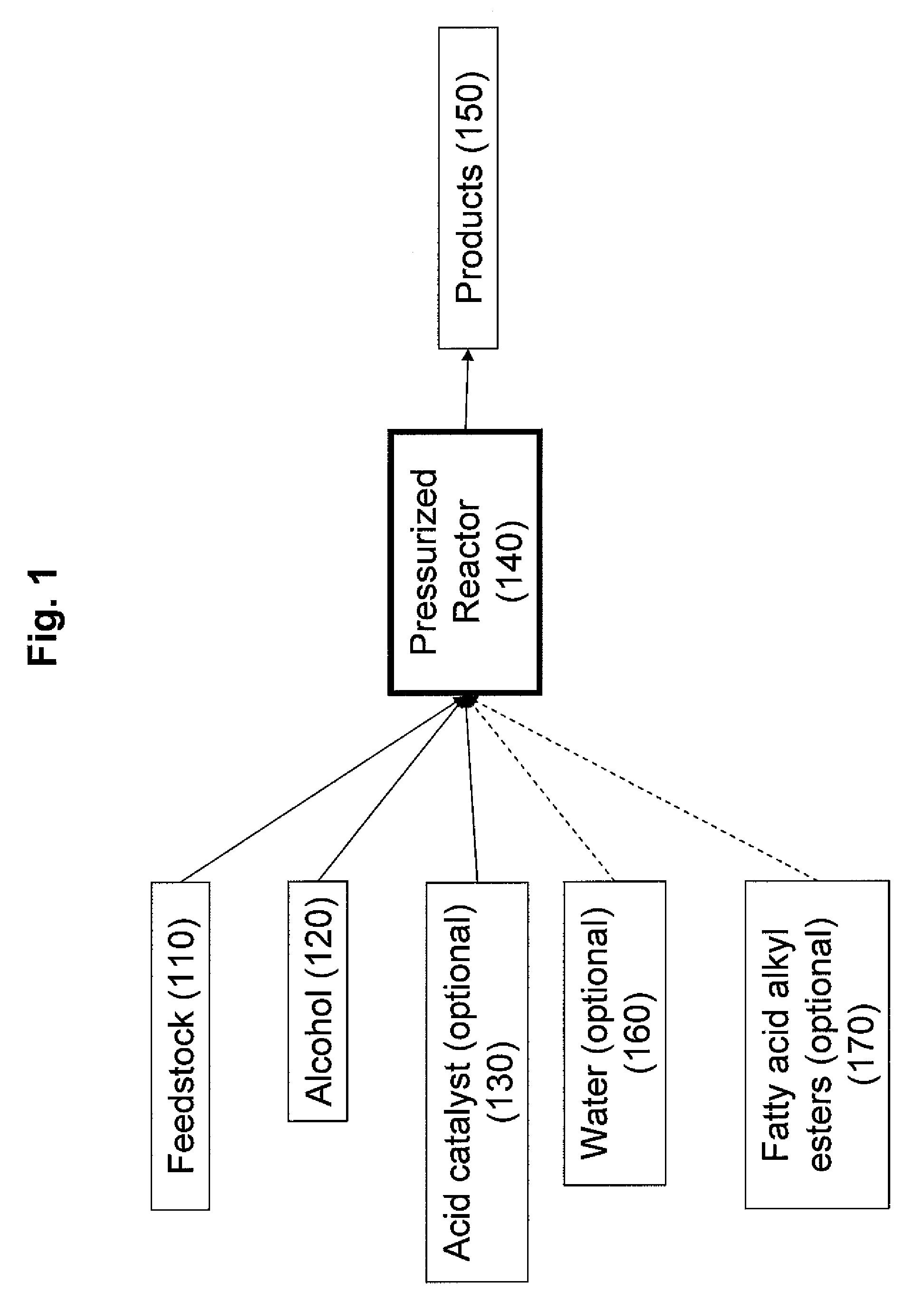Production of biodiesel, cellulosic sugars, and peptides from the simultaneous esterification and alcoholysis/hydrolysis of materials with oil-containing substituents including phospholipids and peptidic content
a cellulosic sugar and esterification technology, applied in the field of esterification of phospholipids, can solve the problems of increased catalyst costs, loss of potential products, and difficulty in product washing, and achieve the effect of preventing alcohol boiling
- Summary
- Abstract
- Description
- Claims
- Application Information
AI Technical Summary
Benefits of technology
Problems solved by technology
Method used
Image
Examples
example 1
Algae Testing
[0060]The following example illustrates the basic process approach and resulting product potential for algae feedstocks. Table 1 summarizes a series of tests conducted with algae feedstocks (either fresh or salt water algae) using the process described above. The initial pH was at 0.4. The temperature was between 140-180° C. The pressure was between 200 and 500 psig. The reaction time was between 1-2 hours. The starting algae contained anywhere from 10% to 25% lipid content of which the FFA values ranged from 5% to as much as 10%. The resulting recovered biodiesel indicated that the contained oil was essentially completely converted to the methyl ester. The percent conversion of oil to fatty acid methyl ester was greater than 95%.
[0061]
TABLE 1Test1234567Dry algae (grams)1,0001,0001,0001,0001,0001,0001,000Acid catalyst (grams)25252525252525MeOH (grains)1500140013001200120012001200ResultsDry weight pulp550544555539553630.5611Fatty Acid Methyl Ester2222192242172239498(FAME...
example 2
Algae Soapstock Testing
[0065]Algae soapstock is a by-product of the conventional algae oil processing route wherein the oil, containing high levels of free fatty acids (FFA), is treated with an alkali solution to neutralize the FFA and produce a “soapstock” that consists of neutralized fatty acids. This material is separated from the aqueous salt solution and typically recovered as a “soapstock” material. A similar product is formed, in large amounts, from soybean oil treatment and is sold, at relatively low cost, for subsequent acidulation and recovery of the fatty acid values, as a free fatty acid, for use in animal feeds or other lower valued applications.
[0066]To assess the potential for soapstocks as feeds, a sample of algae soapstock was obtained and processed in a manner similar to that outlined for the algae (Example 1), with the exception that a solids / liquid separation after the esterification stage was not required. Briefly, the soapstock was initially neutralized with su...
example 3
Distillers Grain
Corn Feedstock
[0069]Distillers grain is a major co-product from the production of ethanol using the conventional corn feedstocks. Dry distillers grain (DDG) is the material remaining after the fermentation process and contains proteins, fats, fiber, ash, and other various components. Much of this material is used in animal feed products, but its value, compared to corn, is lower.
[0070]The quantities of this material are significant. For example, a 100 million gallon / year ethanol facility using a dry corn feed would produce on the order of 660 million pound / year of DDG. In general, the DDG from corn contains about 10% to 11% fat (oil content that is potentially convertible to biodiesel) and about 45% to 50% carbohydrates (which if properly prepared could serve as a fermentation feed).
[0071]It should be noted that with preparation, the resulting sugars consist of both C6 and C5 fractions. The C6 fraction is fermentable via the use of standard yeast materials. C5 sugars...
PUM
| Property | Measurement | Unit |
|---|---|---|
| pressure | aaaaa | aaaaa |
| temperature | aaaaa | aaaaa |
| wt % | aaaaa | aaaaa |
Abstract
Description
Claims
Application Information
 Login to View More
Login to View More - R&D
- Intellectual Property
- Life Sciences
- Materials
- Tech Scout
- Unparalleled Data Quality
- Higher Quality Content
- 60% Fewer Hallucinations
Browse by: Latest US Patents, China's latest patents, Technical Efficacy Thesaurus, Application Domain, Technology Topic, Popular Technical Reports.
© 2025 PatSnap. All rights reserved.Legal|Privacy policy|Modern Slavery Act Transparency Statement|Sitemap|About US| Contact US: help@patsnap.com



